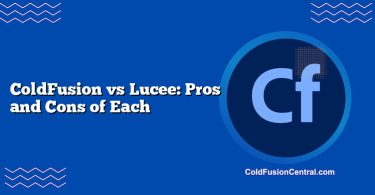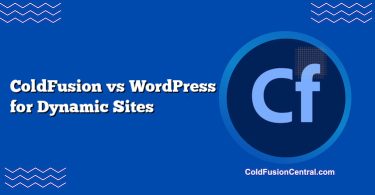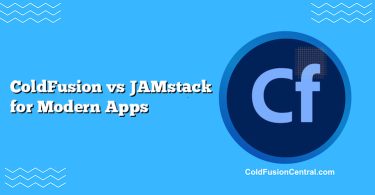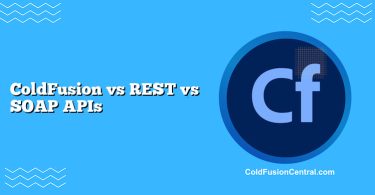Definitions
What is ColdFusion?
ColdFusion is a rapid web application development platform centered on the CFML (ColdFusion Markup Language). Originally created by Allaire and now stewarded by Adobe (with a widely used open-source alternative called Lucee), ColdFusion runs on the Java Virtual Machine (JVM), compiles CFML to Java bytecode, and provides a rich set of built-in services such as PDF generation, email, scheduling, caching, ORM (via Hibernate), REST and SOAP web services, and server-level administration. It’s best thought of as an application server plus language, focused on developer productivity and enterprise features.
What is the Traditional LAMP Stack?
The LAMP stack is a classic open-source web stack: Linux (OS), Apache (web server), MySQL/MariaDB (database), and PHP (or Perl/Python) for the server-side language. Variants include LEMP (Nginx instead of Apache) and LAMPHP (modern PHP with FPM and OPcache). LAMP is modular, widely supported, and ubiquitous for content management systems (WordPress, Drupal), e-commerce (Magento), APIs, and custom web applications.
Overview
Architecture and Runtime
- ColdFusion: Runs atop the JVM as an application server (Adobe ColdFusion or Lucee). It typically sits behind a web server (IIS, Apache, Nginx) via a connector. CFML is interpreted/compiled to bytecode, benefiting from JVM JIT optimizations, garbage collection, and mature Java libraries.
- LAMP: A composition of components. PHP commonly runs as PHP-FPM behind Apache or Nginx. The stack is loosely coupled; you can swap parts (Nginx for Apache, MariaDB for MySQL). Applications are generally stateless processes serving requests from a web server.
Development Experience
- ColdFusion/CFML: Emphasizes speed of development with tag-based syntax (e.g.,
, ) and a JavaScript-like script syntax (CFScript). Many enterprise tasks are one-liners (PDF generation, image manipulation, scheduled tasks). - LAMP/PHP: Leans on frameworks and libraries (Laravel, Symfony, Slim). Composer, modern PHP (7–8.x), strong IDE support, and a massive ecosystem provide flexibility and best practices.
Key Features
ColdFusion / CFML Highlights
- Built-in services: PDF, Office document manipulation, image processing, email, scheduling (cfscheduledtask), WebSocket/event gateways.
- Data access and ORM: cfquery, cfstoredproc, cfqueryparam; ORM via Hibernate annotations or configuration.
- Enterprise operations: Admin console, data source management, caching, session replication (edition-dependent), REST scaffolding, API management in certain editions.
- Tight integration with the JVM: Access Java libraries directly from CFML.
- Open-source option: Lucee offers high performance, active community, and cost-effective deployments.
LAMP Highlights
- Modularity: Swap Apache for Nginx (LEMP), MySQL for MariaDB, or choose PostgreSQL.
- PHP 8.x performance: JIT, OPcache, and FPM deliver strong performance at scale.
- Rich ecosystems: Laravel/Symfony for app structure, WordPress/Drupal for CMS, Composer for dependency management.
- Cloud-native patterns: Easy containerization, autoscaling, and microservices with Docker, Kubernetes, and managed services.
Performance
-
ColdFusion:
- JVM-based engines can deliver excellent throughput with proper tuning (heap sizing, GC tuning, caching).
- CFML’s built-in functions reduce userland overhead for common tasks.
- Database I/O often dominates; careful use of cfqueryparam, connection pooling, and query caching is key.
- Adobe CF and Lucee performance differs per workload; Lucee is often praised for speed in many scenarios.
-
LAMP:
- PHP 8.x + OPcache + FPM yields low-latency responses; Nginx + PHP-FPM is a popular high-performance combo.
- Horizontal scaling is straightforward: replicate stateless PHP app servers behind a load balancer; centralize sessions in Redis.
- Application frameworks add overhead but improve maintainability; caching (HTTP reverse-proxy, Redis, Memcached) mitigates performance costs.
Bottom line: both can be fast. Tuning, database design, and caching strategies influence results more than the platform’s name.
Scalability and High Availability
-
ColdFusion:
- Multi-instance deployments, clustering, and distributed caching are available (some features depend on edition/vendor).
- Can leverage JVM clustering tools, external caches (Redis), message queues (ActiveMQ, RabbitMQ), and container orchestration.
- Stateful features (in-memory sessions) require planning for sticky sessions or external session stores.
-
LAMP:
- Designed for horizontal scale with stateless app nodes.
- Use load balancers, replicated databases (MySQL/MariaDB with read replicas), and managed services.
- Mature patterns for rolling updates, blue/green deployments, and CDN integration.
Security
-
ColdFusion:
- Built-in defenses: cfqueryparam encourages parameterized SQL; server-level lockdown guides; sandbox security; secure profile.
- Centralized server admin eases enforcement of SSL/TLS, cipher choices, and data source restrictions.
- As with any platform, prompt patching is essential. Historical CVEs exist; follow vendor hardening guides.
-
LAMP:
- Security posture varies by distro, web server config, and application framework.
- Modern PHP frameworks provide CSRF protection, input validation, password hashing, and ORM escaping.
- Hardening includes limiting modules, secure PHP-FPM configs, least-privilege DB users, and timely OS/package updates.
Both approaches can be secure when configured and maintained diligently. Governance and patch cadence are decisive.
Cost and Licensing
-
ColdFusion:
- Adobe ColdFusion is commercial; licensing is typically per-core with different editions. Costs include vendor support.
- Lucee is open-source (no license fees); choose paid support if needed through third parties.
- Total cost of ownership (TCO) may be offset by rapid development and fewer third-party add-ons for enterprise features.
-
LAMP:
- Core components are open-source and free.
- Costs are in hosting, managed services, developer time, and optional enterprise support (e.g., Red Hat, Canonical, Percona).
- The vast ecosystem often reduces build time via existing packages and frameworks.
Ecosystem and Community Support
-
ColdFusion:
- Smaller community relative to PHP; strong foothold in government and enterprise, with long-lived codebases.
- Official support channels (Adobe) and active open-source community (Lucee). Fewer third-party libraries than PHP but solid integrations with Java.
-
LAMP:
- Massive global community, abundant documentation, tutorials, Stack Overflow answers, and marketplace solutions.
- Hiring pools for PHP developers are broader; more off-the-shelf components for common needs.
Real-World Use Cases
When ColdFusion Might Be Preferred
- Rapid business app development: Internal enterprise tools needing PDF workflows, scheduled jobs, and integration with legacy systems.
- Organizations with existing CFML assets: Preserving domain logic while modernizing infrastructure (e.g., moving to Lucee on containers).
- Small teams needing enterprise features fast: Built-in services reduce the need to assemble multiple libraries.
Example: A regional government digitizing permit applications uses CFML to generate PDFs, send notifications, and expose a REST API. The team goes from spec to production in weeks, leveraging cfdocument, cfmail, and ORM without hunting for extra libraries.
When LAMP Might Be Preferred
- Content-driven websites and e-commerce: WordPress, WooCommerce, Magento, and Drupal are LAMP mainstays.
- API-first and microservices: PHP + Nginx + containers with Redis/PostgreSQL are easy to scale and deploy in cloud-native environments.
- Cost-sensitive startups: No licensing fees and abundant developers and plugins.
Example: An online retailer launches quickly on a LEMP stack with Magento, scales with CDN + Redis, and uses managed MySQL. The team benefits from plugins, themes, and huge community knowledge.
Side-by-Side Comparison
| Aspect | ColdFusion (Adobe CF / Lucee) | Traditional LAMP (Linux, Apache/Nginx, MySQL/MariaDB, PHP) |
|---|---|---|
| Performance | JVM JIT, strong for enterprise workflows; depends on engine tuning and DB design | PHP 8.x + OPcache/FPM offers excellent latency; scales horizontally easily |
| Cost | Adobe CF is licensed; Lucee is free; smaller plugin needs | Open-source core; costs in hosting, managed services, and dev time |
| Use Cases | Internal apps, PDF-heavy workflows, legacy CFML modernization | CMS, e-commerce, APIs, microservices, content sites |
| Pros | Rapid development; rich built-ins; JVM ecosystem | Huge ecosystem; low entry cost; vast talent pool; modular |
| Cons | Smaller community; potential vendor lock-in (Adobe); fewer ready-made packages | Requires assembling components for some enterprise features; quality varies by framework/package |
Supported Platforms and Deployment Options
-
ColdFusion:
- OS: Windows and Linux (common), macOS for development.
- Web servers: IIS, Apache, Nginx (via connectors).
- Cloud: Docker images, Kubernetes, VM instances; integrates with Java tooling.
- Engines: Adobe ColdFusion (commercial), Lucee (open-source).
-
LAMP:
- OS: Linux distros (Ubuntu, Debian, RHEL/CentOS/AlmaLinux); macOS/Windows for dev via MAMP/WAMP.
- Web servers: Apache or Nginx; PHP-FPM recommended for performance.
- Databases: MySQL or MariaDB; often swapped for PostgreSQL.
- Cloud: Extensive support; easy containerization; managed DB and caching services.
Language and Syntax Differences (Quick Glance)
| Pattern | ColdFusion / CFML | PHP |
|---|---|---|
| Variables | myVar = “hello”; or |
$myVar = “hello”; |
| Conditionals | if (x gt 5) { … } or <cfif x GT 5> | if ($x > 5) { … } |
| Database query | PDO/MySQLi with prepared statements | |
| Templating | CFML tags and CFScript; built-in functions | Native PHP templates or Blade/Twig via frameworks |
| Built-ins | PDF, mail, image, scheduling in core platform | Use libraries/frameworks (TCPDF, PHPMailer, Intervention Image, cron) |
Note: Both support MVC via frameworks (ColdBox for CFML; Laravel/Symfony for PHP).
Pros and Cons
ColdFusion
Pros:
- Extremely fast development for enterprise features (PDF, mail, scheduling) with minimal boilerplate.
- JVM-based runtime with access to mature Java libraries.
- Centralized admin and built-in tooling simplifies ops.
Cons:
- Commercial licensing for Adobe CF; smaller talent pool.
- Fewer off-the-shelf packages than PHP ecosystems.
- Perception of legacy may affect hiring and long-term strategy, despite active usage.
LAMP
Pros:
- Open-source, low-cost adoption; abundant hosting options.
- Massive ecosystem of frameworks, CMSs, and plugins.
- Easy horizontal scaling patterns; strong community support.
Cons:
- Assembling “enterprise” features often requires multiple libraries and services.
- Quality and security vary across the ecosystem; curation and governance are required.
- Performance tuning is a must at scale (FPM, OPcache, caching layers).
Decision Factors / Which One Should You Choose?
Consider the following:
- Team expertise: If your developers know CFML or you’re modernizing existing CF apps, ColdFusion (or Lucee) keeps momentum. If your team knows PHP/Laravel, LAMP accelerates delivery.
- Time-to-value vs. modularity: ColdFusion offers rapid delivery of enterprise features out of the box. LAMP offers modular freedom with a richer plugin universe.
- Budget and licensing: If you want no license fees and maximum flexibility, LAMP fits. If enterprise support and fewer moving parts matter, Adobe CF might justify its cost; Lucee offers a no-cost CFML path.
- Cloud-native and microservices: LAMP (or more precisely, PHP with Nginx and containers) is familiar and well-supported. ColdFusion can be containerized and scaled too, but patterns and tooling are less common in the mainstream.
- Long-term hiring and community: PHP has a larger hiring pool and community content. CFML talent is more niche but stable in certain sectors.
- Integration needs: If you need first-class PDF generation, scheduled jobs, and quick REST scaffolding without assembling packages, ColdFusion shines. If you prefer selecting specialized best-in-class tools for each concern, LAMP excels.
Rule of thumb:
- Choose ColdFusion/Lucee if you prioritize rapid enterprise feature delivery, have CFML expertise, or are evolving existing CF applications.
- Choose LAMP if you want open-source flexibility, a massive ecosystem, easy hiring, and cloud-native scaling patterns.
Key Takeaways
- Both ColdFusion (Adobe CF or Lucee) and LAMP can deliver high performance and robust security when well-architected.
- ColdFusion emphasizes rapid development with built-in enterprise capabilities; LAMP emphasizes modularity and community-driven solutions.
- Costs differ: Adobe CF is licensed, Lucee and LAMP are open-source. TCO depends on team skills, time-to-market, and ops complexity.
- Ecosystem size and hiring favor LAMP; integrated enterprise tooling favors ColdFusion.
- The “best” choice depends on your context: existing codebase, developer skill set, non-functional requirements, and budget.
FAQ
Is ColdFusion still viable for new projects?
Yes. ColdFusion (and Lucee) remains viable, especially for teams who value rapid development of enterprise features or have CFML experience. While its community is smaller than PHP’s, the platform continues to evolve and powers many production systems.
Can I use an open-source engine for CFML instead of Adobe ColdFusion?
Absolutely. Lucee is a popular, performant open-source CFML engine. It lowers licensing costs and runs on the JVM, making it attractive for modernization and container-based deployments.
Does LAMP only mean PHP?
Traditionally LAMP includes PHP, but the “P” can also stand for Perl or Python. In practice, PHP is the most common, and many teams use variants like LEMP (Nginx) or swap databases (e.g., PostgreSQL).
Which is better for microservices and serverless?
Both can work, but PHP’s ecosystem and tooling around containers, FaaS platforms, and managed runtimes are more pervasive. ColdFusion can be containerized and orchestrated, but PHP often has broader community patterns and templates ready to go.
How hard is it to migrate from ColdFusion to LAMP (or vice versa)?
It depends on code complexity, business logic, and integrations (PDF, scheduled tasks, ORM). For ColdFusion to LAMP, identify feature parity (e.g., replace cfdocument with a PHP PDF library), plan data access changes, and refactor templates/components to a PHP framework. For LAMP to CF, leverage CF’s built-ins to consolidate libraries and simplify deployment. In both cases, incremental migration and strangler-fig patterns reduce risk.




